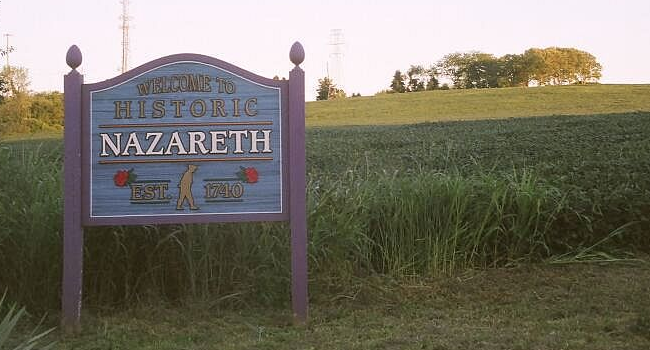The Moore Township Zoning Hearing Board met Wednesday, September 21 to continue the Water’s Edge at Wind Gap appeal. The ongoing appeal that began in June challenges the substantive validity of various sections of the township’s zoning ordinance and zoning officer determinations.
During the previous meeting, Township Solicitor David Backenstoe conducted a direct examination of Township Engineer Kevin Horvath as the township’s first witness. The hearing resumed with the applicant’s representation, Attorney Marc B. Kaplin, cross-examining Horvath.
Kaplin began by asking Horvath to confirm that the Keystone Consulting Engineers review letters dated Sept. 23, 2021 and Jan. 24, 2022 both state the same comment that the applicant needs to provide detailed information to the township at the time of application of the zoning permit relative to the types of activities to be conducted on the site, hours of operation, times of delivery, etc.
Horvath confirmed that he did.
Kaplin presented that Engineer Stephen M. Walsh provided a response letter from Dynamic Engineering Consultants on Dec. 8, 2021, which stated that the requisite information will be supplied at the time of the zoning permit and that a covenant note will be added to the record plan consistent with this requirement as a promise of future action.
Kaplin established that his client does not have to obtain a zoning permit until he has a tenant to occupy the warehouse and that the applicant has submitted as much information as they possibly can at this time in the development process based on general warehouse use.
Based on the zoning officer’s interpretation of the zoning ordinance, Kaplin alleged that his client will never be able to develop a warehouse on their property unless they have a tenant. Kaplin asked Horvath what additional information he would require. Horvath responded that he would need to sit down and discuss this with the applicant. Kaplin claimed that Horvath should have called Walsh to obtain the necessary information to satisfy the requirement.
Backenstoe objected on the basis that it presumes that the township engineer has an obligation to call the applicant, when generally, the applicant responds to the township engineer’s letter.
Kaplin established that Walsh filed a parking and loading compliance plan, which demonstrates that the proposed development meets the minimum requirements of the zoning ordinance. Kaplin presented that Walsh’s Dec. 8, 2021 response letter addresses that “parking, loading, and staging will be refined based on the tenant’s needs at the time of zoning permit, which is consistent with [Horvath’s] direction to supply information at the time of zoning permit.”
Kaplin established that the applicant meets the requirements for parking, loading, and staging spaces, but that the applicant cannot determine the exact number of required spaces until the tenant is known in regard to what their truck traffic and number of employees will be.
Kaplin expressed that the parking requirements based on square feet versus number of employees is inconsistent and therefore the applicant cannot meet the requirements of both at this time.
Horvath asserted that the requirements are not mutually exclusive.
Next, Kaplin pointed to section 200-35 of the zoning ordinance, subsection VI Environmental Protection Standards, which states: “The purpose of this section is to protect and preserve the environment and the character of the township through the preservation of natural resources including but not limited to wetlands, floodplains, floodplain soils, woodlands, steep slopes, and riparian carvers.”
Kaplin established that this ordinance discusses protecting natural resources and does not include man-made resources. Kaplin argued that section 200-35.A.3: Natural Resource Identification and Preservation Standards only applies to natural resources.
Horvath confirmed that the ordinance does not indicate whether the steep slopes on the golf course occurred naturally or were man-made. Horvath explained that his interpretation does not exclude man-made slopes under the environmental protection standards and that he has not seen any evidence that indicates all of the slopes on the plan shown in gray are man-made steep slopes created by the golf course, aside from Walsh’s testimony.
Next, Kaplin addressed the placement of the 100-foot raised berm buffer yard requirement along the lot line. Horvath testified that the raised berm buffer yard can be located anywhere between the building and the lot line. Therefore, Horvath identified that if the buffer yard extends 100 feet, it can begin farther in or away from the property line as long as it runs parallel to the lot line.
Kaplin argued that the 100-foot berm requirement from the lot line would position the berm where the woodlands currently are, which would destroy the woodlands, but Horvath expressed that putting the berm behind the woodlands would be in compliance with the ordinance.
During Backenstoe’s redirect examination of Horvath, he established that the applicant never provided a response or clarification pursuant to two questions following the Jan. 24, 2022 review letter that would have assisted Horvath in his review process prior to the hearing.
Following, Backenstoe established that the definition of steep slopes does not indicate that man-made steep slopes are not applicable to environmental protection standards, and therefore, does not exclude them per Horvath’s testimony.
During Kaplin’s recross-examination of Horvath, he alleged that after slopes are changed, they are no longer in their natural condition, which he argued would exclude them from environmental protection standards.
Zoning Board member Zachary Zeitner asked Horvath whether something man-made becomes a natural feature or resource once it is developed. Horvath confirmed that this was his interpretation.
Zoning Board Solicitor Chad DiFelice asked Kaplin what the applicant plans to do if the future tenant has higher levels of truck traffic or employees than previously estimated, and whether the applicant would agree to a restriction on the number of trucks and employees allowed.
Kaplin expressed that the applicant would redo the calculations for parking, loading, and staging spaces in compliance with the ordinance when a tenant is established.
DiFelice also asked for clarification on the applicant’s position on several items. Kaplin asserted that the applicant’s position on man-made steep slopes is that they are man-made and not natural, therefore, man-made steep slopes should not be applicable to the environmental protection standards because they did not occur naturally. Kaplin also clarified that the applicant’s position is that they cannot meet both the buffer yard and woodland requirements at the same time and requested a variance so they would not be required to build the berm.
Kaplin requested that he be allowed to prepare proposed findings of fact, proposed conclusions of law, and to submit a memorandum of law after the next hearing, which the board was amenable to. Therefore, after the remaining testimony and public comment at the next meeting, both parties will be provided 30 days to submit their findings of fact and conclusions of law to the board. Then, after the next meeting and the 30-day period for the attorneys to provide findings of fact and proposed conclusions of law, the Zoning Hearing Board will reconvene to render their decision.
The next meeting will reconvene for additional testimony and public comment on Thursday, October 27 at 6 p.m. at the Klecknersville Rangers Volunteer Fire Company, located at 2718 Mountain View Dr.








